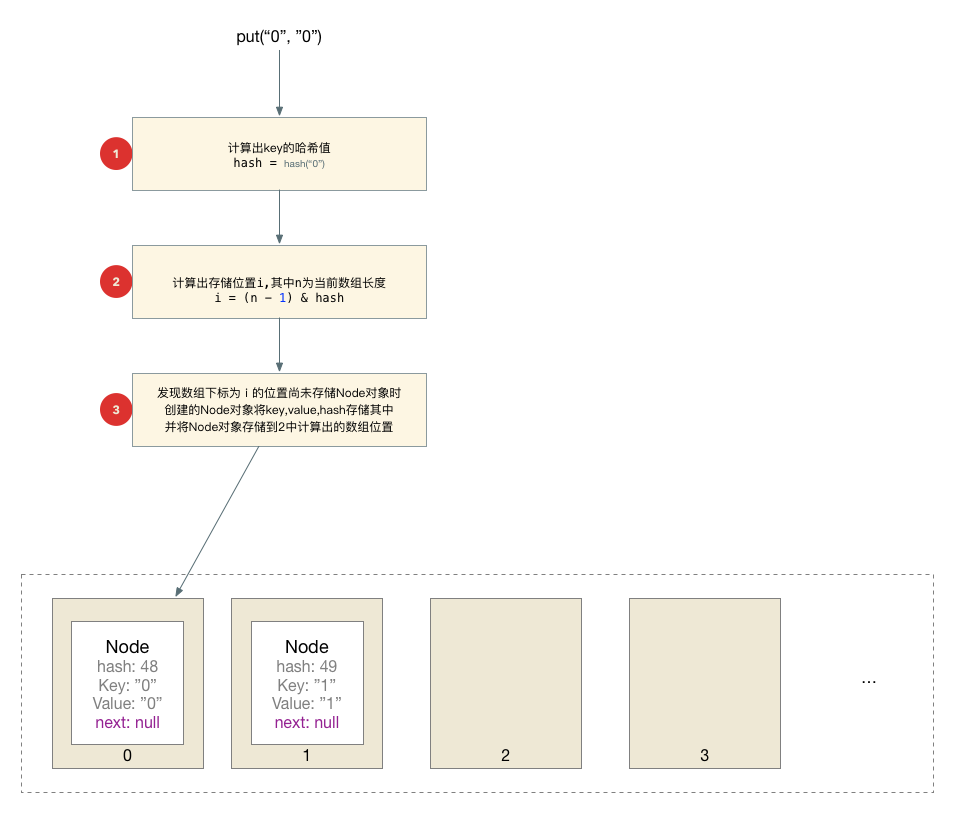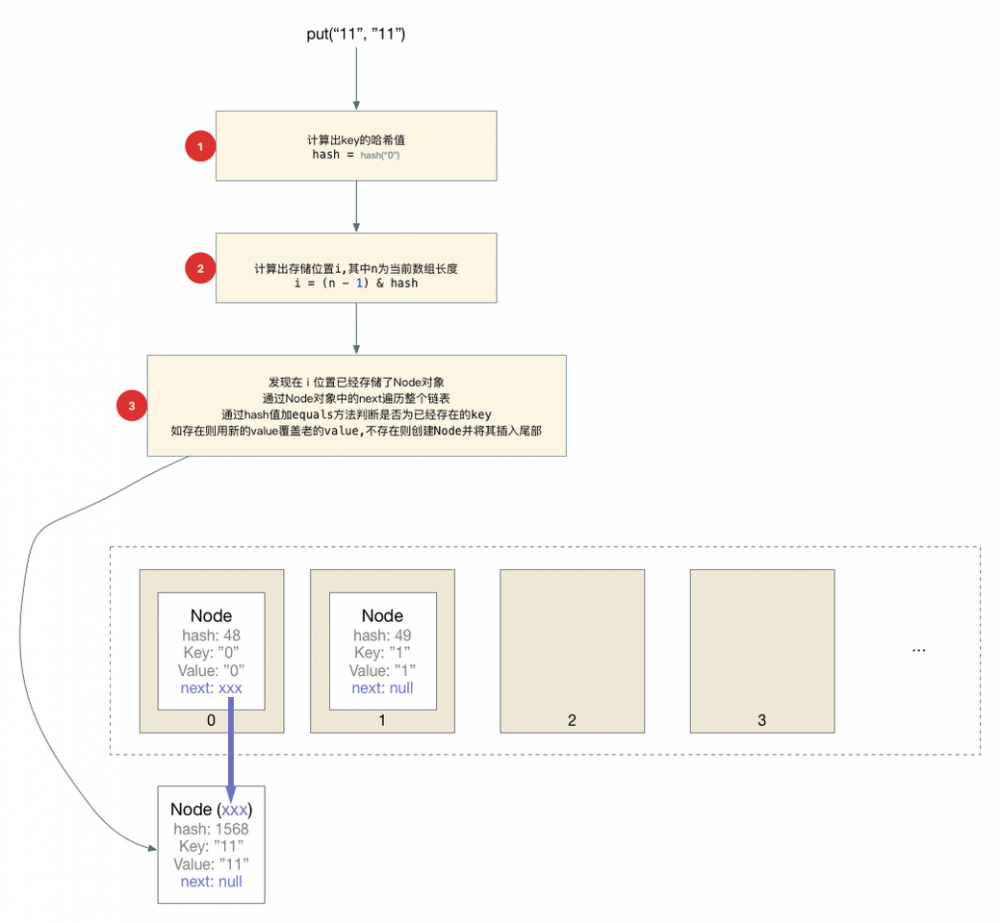JDK1.8源码分析笔记-HashMap

1. 计算出key的hash值
static final int hash(Object key) {
int h;
return (key == null) ? 0 : (h = key.hashCode()) ^ (h >>> 16);
}
复制代码
扰动处理混合哈希码的高位和低位(实际上只扰动了低位)。经过扰动处理,使得存储Node的数组长度在很小的时候(即取的低位很少时)减少冲突。
2. 计算出存储位置 i
i = (n - 1) & hash 复制代码
其中n为数组长度缺省为16见HashMap类的常量定义
/** * The default initial capacity - MUST be a power of two. */ static final int DEFAULT_INITIAL_CAPACITY = 1 << 4; // aka 16 复制代码
一般我们常见的固定范围均匀分散用%(模运算),这边使用&(与运算)是因为与运算具有更好的性能。
通过测试发现&操作在对0~100的数据分散到15个位置时并不能很好的均匀分布,但是在分散到16个位置时就没有问题。这是因为16的二进制数据为10000 低位全是0,减1后为1111,这时&运算等价于%模运算。 这就是很多面试题中提到的为什么HashMap的数组长度必须是2的n次幂的原因。
3. 创建Node对象并存储到数组中
final V putVal(int hash, K key, V value, boolean onlyIfAbsent,
boolean evict) {
...
if ((p = tab[i = (n - 1) & hash]) == null)
tab[i] = newNode(hash, key, value, null);
...
}
Node<K,V> newNode(int hash, K key, V value, Node<K,V> next) {
return new Node<>(hash, key, value, next);
}
复制代码
不同的key计算出相同的存储位置怎么办

public V put(K key, V value) {
return putVal(hash(key), key, value, false, true);
}
final V putVal(int hash, K key, V value, boolean onlyIfAbsent,
boolean evict) {
Node<K,V>[] tab; Node<K,V> p; int n, i;
// 1. 初始化table数组
if ((tab = table) == null || (n = tab.length) == 0)
n = (tab = resize()).length;
// 2. 根据key的hash值计算出Node存放在数组中的位置,如果为null则直接存储
if ((p = tab[i = (n - 1) & hash]) == null)
tab[i] = newNode(hash, key, value, null);
else {
// 3. 即将放入的key与之前存储的key一致
Node<K,V> e; K k;
if (p.hash == hash &&
((k = p.key) == key || (key != null && key.equals(k))))
e = p;
// 4. 之前存储的Node已经升级为红黑数结构
else if (p instanceof TreeNode)
e = ((TreeNode<K,V>)p).putTreeVal(this, tab, hash, key, value);
else {
// 5. 遍历链表不存在则新增,长度>=8时链表转换成红黑树
for (int binCount = 0; ; ++binCount) {
if ((e = p.next) == null) {
p.next = newNode(hash, key, value, null);
if (binCount >= TREEIFY_THRESHOLD - 1) // -1 for 1st
treeifyBin(tab, hash);
break;
}
if (e.hash == hash &&
((k = e.key) == key || (key != null && key.equals(k))))
break;
p = e;
}
}
// 6. 存在则替换就的value
if (e != null) { // existing mapping for key
V oldValue = e.value;
if (!onlyIfAbsent || oldValue == null)
e.value = value;
afterNodeAccess(e);
return oldValue;
}
}
++modCount;
// 7. 长度大于阀值进行扩容
if (++size > threshold)
resize();
afterNodeInsertion(evict);
return null;
}
复制代码
总结:
- key的引用地址相等或者key的hash值相等并且equals方法返回true则认为是相同的key,在设置了onlyIfAbsent=false 或者 旧的值为null时将进行替换
- 当链表长度>=8时为了提高查询效率会将链表结构转化为红黑树(红黑树细节会在TreeMap的源码解读中详细描述)
- modCount用于记录HashMap的修改次数,HashMap不是线程安全的在读取时修改数据迭代器就会抛出ConcurrentModificationException异常
- 存储的键值对的个数>阀值(容量*负载因子)时会进行数组扩容
- 负载因子缺省为0.75这是一个权衡值。太大会加剧hash冲突,太小会造成空间浪费
如何扩容
/**
* resize方法会在第一次初始化或者容量不够时被调用
*/
final Node<K,V>[] resize() {
Node<K,V>[] oldTab = table;
int oldCap = (oldTab == null) ? 0 : oldTab.length;
int oldThr = threshold;
int newCap, newThr = 0;
if (oldCap > 0) {
if (oldCap >= MAXIMUM_CAPACITY) {
threshold = Integer.MAX_VALUE;
return oldTab;
}
// 没有超过最大值则扩容为原来数组长度的2倍
else if ((newCap = oldCap << 1) < MAXIMUM_CAPACITY &&
oldCap >= DEFAULT_INITIAL_CAPACITY)
newThr = oldThr << 1; // double threshold
}
else if (oldThr > 0) // initial capacity was placed in threshold
newCap = oldThr;
else { // zero initial threshold signifies using defaults
newCap = DEFAULT_INITIAL_CAPACITY;
newThr = (int)(DEFAULT_LOAD_FACTOR * DEFAULT_INITIAL_CAPACITY);
}
if (newThr == 0) {
float ft = (float)newCap * loadFactor;
newThr = (newCap < MAXIMUM_CAPACITY && ft < (float)MAXIMUM_CAPACITY ?
(int)ft : Integer.MAX_VALUE);
}
threshold = newThr;
@SuppressWarnings({"rawtypes","unchecked"})
Node<K,V>[] newTab = (Node<K,V>[])new Node[newCap];
table = newTab;
if (oldTab != null) {
for (int j = 0; j < oldCap; ++j) {
Node<K,V> e;
if ((e = oldTab[j]) != null) {
oldTab[j] = null;
if (e.next == null)
newTab[e.hash & (newCap - 1)] = e;
else if (e instanceof TreeNode)
((TreeNode<K,V>)e).split(this, newTab, j, oldCap);
else { // preserve order
// 将旧的链表拆分成两个链表
// 拆分规则:将hash与扩容后新增的参与运算的位进行&运算如果为0则存储的原始位置,为1则存储在原始位置+扩容前的容量
Node<K,V> loHead = null, loTail = null;
Node<K,V> hiHead = null, hiTail = null;
Node<K,V> next;
do {
next = e.next;
if ((e.hash & oldCap) == 0) {
if (loTail == null)
loHead = e;
else
loTail.next = e;
loTail = e;
}
else {
if (hiTail == null)
hiHead = e;
else
hiTail.next = e;
hiTail = e;
}
} while ((e = next) != null);
if (loTail != null) {
loTail.next = null;
newTab[j] = loHead;
}
if (hiTail != null) {
hiTail.next = null;
newTab[j + oldCap] = hiHead;
}
}
}
}
}
return newTab;
}
复制代码
总结:
- 扩容为原来数组长度的2倍
- 遍历旧的数据将其移动到新的数组中,遇到链表时将旧的链表拆分成两个链表 拆分规则:将hash与扩容后新增的参与运算的位进行&运算如果为0则存储的原始位置,为1则存储在原始位置+扩容前的容量(原因是使用的2次幂的扩展即高位增加一位比如16扩容到32 二进制参与&运算的n-1 由1111变成11111, 即hash需要与新增的高位10000进行&运算 ,运算结果为0即数组下标为原始位置;运算结果为1则数组下标为原始位置+扩容前旧的容量)
GET方法为何能快速获取值
public V get(Object key) {
Node<K,V> e;
return (e = getNode(hash(key), key)) == null ? null : e.value;
}
final Node<K,V> getNode(int hash, Object key) {
Node<K,V>[] tab; Node<K,V> first, e; int n; K k;
// 计算存放在数组table中的位置
if ((tab = table) != null && (n = tab.length) > 0 &&
(first = tab[(n - 1) & hash]) != null) {
// 依次在数组、红黑树、链表中查找(通过equals()判断)
// 1. 数组查找
if (first.hash == hash && // always check first node
((k = first.key) == key || (key != null && key.equals(k))))
return first;
if ((e = first.next) != null) {
// 2. 红黑树查找
if (first instanceof TreeNode)
return ((TreeNode<K,V>)first).getTreeNode(hash, key);
// 3. 链表查找
do {
if (e.hash == hash &&
((k = e.key) == key || (key != null && key.equals(k))))
return e;
} while ((e = e.next) != null);
}
}
return null;
}
复制代码
HashMap在日常使用中会有哪些问题?
线程不安全
JDK1.7 并发操作时resize方法易出行链表遍历死循环,JDK 1.8 转移数据操作 = 按旧链表的正序遍历链表、在新链表的尾部依次插入,所以不会出现链表 逆序、倒置的情况,故不容易出现环形链表的情况。
key为Object类型需要注意哪些问题
- hashCode() 用于计算存储位置,选择不恰当易造成hash碰撞影响性能
- equals() 保证key在哈希表中的唯一性
- hashCode()、equals() (如果进行重写操作,一定要确保同时被正确重写)
正文到此结束
热门推荐
相关文章
Loading...











![[HBLOG]公众号](https://www.liuhaihua.cn/img/qrcode_gzh.jpg)

